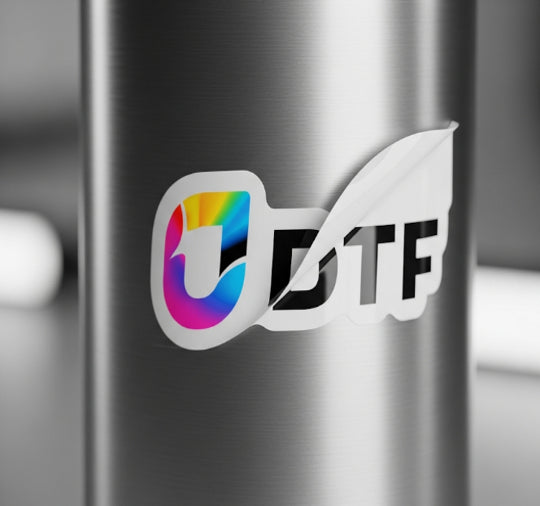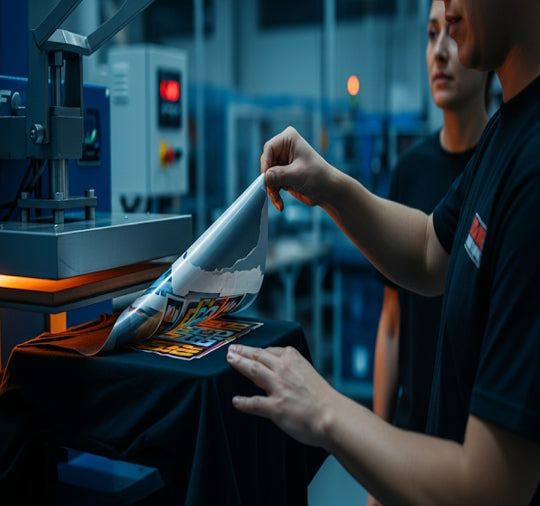Article at a Glance:
- Direct to Film (DTF) transfer technology represents a revolutionary advancement in product decoration, combining sophisticated engineering with chemical innovation to enable versatile, precise customization across diverse materials.
- The technology relies on critical components including specialized PET film, pigment-based inks, and hot-melt adhesive powders, all working in harmony through precise digital workflows and temperature-controlled environments.
- While offering unprecedented flexibility and reduced setup times, DTF implementation requires significant investment in infrastructure, staff training, and environmental controls, along with careful consideration of material costs and substrate compatibility.
- Success with DTF technology demands a strategic approach to implementation, encompassing everything from sophisticated digital workflow integration to comprehensive waste management and safety protocols.
This comprehensive transformation in product decoration technology opens new possibilities for businesses seeking to enhance their customization capabilities while navigating the complexities of modern manufacturing demands.
In today's fast-paced manufacturing landscape, where personalization reigns supreme, Direct to Film (DTF) transfer technology has burst onto the scene, revolutionizing how businesses approach product decoration. The rising popularity of direct to film transfers has transformed everything from small print shops to large-scale manufacturing operations, offering a simpler alternative to traditional methods that often require complex setup processes.
Think of DTF as the Swiss Army knife of product decoration – versatile, precise, and surprisingly elegant in its execution. The technology has carved out its niche by offering a unique blend of flexibility and precision that's particularly captivating for businesses looking to break free from conventional decoration constraints.
The Magic Behind DTF: A Deep Dive into Core Components

At its heart, DTF technology is a symphony of precision engineering and chemical innovation. The process begins with specialized pigment-based inks dancing across polyethylene terephthalate (PET) film, creating vibrant designs that seem to float on the surface. This isn't just any ordinary film – we're talking about precisely engineered sheets, typically ranging from 75 to 100 microns in thickness, that serve as the perfect canvas for these specialized inks.
Essential components that make direct to film transfers possible include:
- A sophisticated DTF printer equipped with piezoelectric printheads that deposit ink with microscopic precision, much like a master painter wielding their finest brush
- Specially coated PET film that's engineered to achieve the perfect balance between ink adhesion and release properties
- Hot-melt adhesive powder (typically TPU or modified polyester-based) with particles sized between 80-150 microns for optimal bonding
- Professional-grade heat curing units featuring precise digital temperature control systems
- Commercial heat presses designed to maintain perfectly consistent pressure distribution
Mastering the Technical Symphony
Running a successful DTF operation is like conducting an orchestra – every element must work in perfect harmony. Environmental control plays a crucial role in this delicate balance. The ideal production environment maintains specific conditions that might seem stringent but are crucial for success:
Temperature Management Essentials:
- Consistent heat press temperature verification before each production run
- Regular calibration of heating elements to ensure uniform heat distribution
- Comprehensive temperature mapping across the entire press surface
The relationship between powder application and final print durability is particularly fascinating. Much like a chef carefully seasoning a dish, the uniform distribution of powder across the design area determines the final product's durability and wash resistance. This critical step requires both technical precision and a well-developed sense of timing.
Breaking Through Traditional Boundaries

DTF technology shatters conventional limitations in product decoration, offering unprecedented flexibility in substrate compatibility. The versatility of direct to film transfers stems from their unique approach to design transfer, which eliminates many traditional barriers:
Material Compatibility Advantages:
- Seamless printing capability across diverse materials including cotton, polyester, nylon, and even leather
- Exceptional transfer consistency on both light and dark materials without the need for separate processes
- Superior adhesion properties that bridge the gap between natural and synthetic substrates
The technology's digital workflow dramatically reduces traditional setup requirements, while the ability to store transfers enables a revolutionary approach to on-demand production. Through specialized RIP software, color management achieves a level of precision that was once considered impossible in transfer printing.
Understanding Real-World Limitations and Challenges
While DTF technology opens new doors in product decoration, it's essential to acknowledge its limitations with clear eyes. The technology introduces certain trade-offs that businesses must carefully weigh against their specific needs and customer expectations.
The adhesive layer, while crucial for durability, creates a distinct tactile signature that sets DTF apart from other printing methods. This characteristic becomes particularly noticeable in designs with large solid areas, where the difference in texture compared to direct printing or dye sublimation can be more pronounced. Additionally, the adhesive layer can impact fabric breathability in printed areas – a crucial consideration when working with athletic or performance wear.
Cost considerations present another layer of complexity. While direct to film transfers reduce setup times and minimize waste, the specialized materials required – from PET film to pigment inks and adhesive powders – often command premium prices. However, these higher material costs should be evaluated against the technology's ability to enable quick turnaround times and minimize inventory requirements.
Strategic Implementation: From Vision to Reality
Successful DTF implementation requires a methodical approach that goes beyond simply installing equipment. Think of it as building a high-performance engine – each component must be carefully selected and precisely tuned for optimal performance.
Critical infrastructure requirements include:
- Dedicated production spaces with sophisticated environmental controls
- Robust electrical systems (typically 220V) with appropriate surge protection
- Advanced HVAC systems capable of maintaining precise environmental conditions
- State-of-the-art ventilation systems with specialized filtration for powder management
Staff development emerges as a cornerstone of successful implementation:
- Comprehensive training in digital file preparation and color management
- In-depth equipment operation and maintenance protocols
- Rigorous quality control procedures and documentation methods
- Advanced troubleshooting techniques and problem resolution strategies
Digital Workflow Integration: The Key to Efficiency

Modern DTF systems thrive on seamless digital workflow integration. This integration transforms traditional production methods into streamlined, data-driven processes that maximize efficiency and minimize errors.
The digital backbone of a DTF operation includes:
- Sophisticated file preparation and color profile management systems
- Advanced job queuing and scheduling capabilities
- Real-time production tracking and monitoring tools
- Integrated quality control checkpoints throughout the process
The implementation journey typically unfolds through several distinct phases, each building upon the previous:
Initial Setup and Validation:
- Precise equipment installation and calibration procedures
- Comprehensive staff training and certification processes
- Thorough process validation through controlled test production
- Strategic production scaling based on performance metrics
Environmental Stewardship and Safety Protocols
Responsible DTF implementation demands a deep commitment to environmental sustainability and safety. This commitment extends beyond basic compliance to embrace comprehensive waste management and safety protocols that protect both workers and the environment.
Smart waste management strategies have become increasingly crucial in modern DTF operations. Leading facilities now implement sophisticated recycling programs for PET film, utilizing specialized collection systems that minimize environmental impact while maximizing resource efficiency. The management of powder systems requires particular attention, with advanced containment solutions that prevent waste while ensuring optimal application.
Safety considerations permeate every aspect of DTF operations:
- State-of-the-art ventilation systems that exceed industry standards
- Carefully selected personal protective equipment for different operational roles
- Detailed material handling procedures that prioritize worker safety
- Comprehensive emergency response protocols with regular team training
Future-Proofing Your DTF Operation
The DTF technology landscape continues to evolve at a breathtaking pace, with innovations emerging in ink formulations, automation capabilities, and software integration. Forward-thinking businesses are already preparing for the next wave of advancements, developing scalable implementation strategies that accommodate both current needs and future growth.
Key considerations for sustainable growth include:
- Modular system designs that allow for seamless expansion
- Integration-ready platforms that can accommodate emerging automation technologies
- Workflow systems designed for continuous optimization
- Strategic space planning that anticipates future equipment needs
Conclusion: Embracing the Future of Product Decoration
DTF technology represents more than just another decoration method – it's a paradigm shift in how businesses approach product customization. Success in this evolving landscape requires a delicate balance of technical expertise, strategic planning, and adaptability to change.
The technology's impact extends beyond mere production capabilities, touching every aspect of business operations from customer relationships to supply chain management. As the industry continues to evolve, businesses that embrace direct to film transfers while maintaining a commitment to excellence in implementation and operation will find themselves well-positioned for future success.
Frequently Asked Questions (FAQs)
Q: How does DTF technology truly differentiate itself in the market?
A: Beyond its technical capabilities, DTF technology represents a fundamental shift in decoration flexibility, offering unprecedented substrate compatibility while eliminating many traditional pretreatment requirements. The technology's unique approach to design transfer opens new possibilities in customization and small-batch production.
Q: What are the real costs of implementing DTF technology?
A: While initial system investments typically range from $15,000 to $50,000, the true cost consideration extends beyond equipment. Businesses must factor in specialized consumables, environmental control systems, and comprehensive staff training programs.
Frequently Unasked Questions (FUQs)
Q: How does DTF technology impact broader business strategies?
A: The technology fundamentally transforms inventory management and production planning, enabling true on-demand manufacturing capabilities while requiring new approaches to supplier relationships and quality control systems.
Q: What hidden challenges emerge during implementation?
A: Beyond obvious technical requirements, businesses often encounter unexpected challenges in:
- Environmental control system modifications
- Comprehensive staff training requirements
- Workflow restructuring needs
- Development of new quality control protocols
Premium DTF Transfers for Bold, Long-Lasting Prints!
Need high-quality, durable, and versatile Direct to Film (DTF) transfers? At Best Price DTF, we specialize in vibrant, wash-resistant prints that bring your custom designs to life. From DTF sheets to gang sheets, we provide top-tier solutions for all your printing needs.
⭐ Trusted by creators like you!
"The DTF Transfers applied as expected." – Xavier Treadwell
📩 Contact us today to get started on your next custom print project! Have questions? Our experts are here to help.

